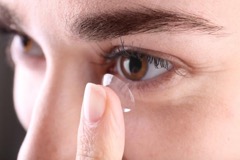As you get older, your vision can start to suffer. Most people who reach the age of 40 and above might start to notice that they have to hold things close to them a little farther away so that they come into focus. When you begin to lose the ability to see things close up, the medical term is “presbyopia.” “If you are experiencing presbyopia, you might be wondering about the differences between bifocals and multifocal contact lenses, and which choice is right for your condition and circumstances. Silicone hydrogel lenses might be ones you want to try. Multifocal and bifocal lenses are both made from the same material, but they differ in how they help the person see things.
How do bifocals and multifocal lenses differ?
 Multifocal lenses are similar to what eyecare specialists call “progressive” lenses, because they allow you to see both near and far and everywhere in between. Like a whole new set of eyes, multifocal lenses are just what the name implies: they help you to see everything. Bifocal lenses are limited in that they have one side of the lens that allows someone to see things that are close by, and then another lens that gives you the capacity to see far away. Those things that lie in between are sometimes difficult to focus on.
Multifocal lenses are similar to what eyecare specialists call “progressive” lenses, because they allow you to see both near and far and everywhere in between. Like a whole new set of eyes, multifocal lenses are just what the name implies: they help you to see everything. Bifocal lenses are limited in that they have one side of the lens that allows someone to see things that are close by, and then another lens that gives you the capacity to see far away. Those things that lie in between are sometimes difficult to focus on.
What are the various types of multifocal contact lenses?
There are multiple types of multifocal contact lenses, and the best choice for you depends on why you need them.
Simultaneous vision lenses and custom non prescription lenses keep both the “near” and “far” zones right in the center of your pupil simultaneously. Although they take a little more time to get used to, after you do your brain is capable of ignoring one lens over the other according to what your eyes are looking at. Simultaneous lenses are the most common type of multifocal lenses and are available in different designs.
The aspheric design allows the person to blend across the top of the lens to see both close and far away. Some types of aspheric lenses have the power to see distances in the center of the eye, while other have the power near the center, but not right in the middle.
The concentric style is a ringed design that has both distance and close up lenses in the center, but there are alternating rings that allow you to see different rings or zones surrounding the center when you are trying to focus on things that are either near or far away.
Translating or alternative vision lenses are multifocal lenses that are closely designed to mimic bifocal glasses. One part of the lens is used to focus on things that are close up and the other portion allows you to see things that are further away. When a person is looking straight ahead, they can see distance, but when they look slightly down, the lower part of the lens allows their pupil to see things that are closer.
Who are multifocal lenses appropriate for?
The majority of people who choose multifocal contact lenses are pleased with their performance. But there are times when people have a hard time focusing without blurred vision in switching from close to far. Multifocal lenses are also known to cause people problems at night due to the glare that they can sometimes give off.
There are times when someone with presbyopia may try a modified monovision type of lens, a single-use lens that means they only have the power to see either distance or close up, instead of opting for the multifocal lenses. To use modified monovision contact lenses, you wear one contact lens in one eye to correct for seeing close up, and the other prescription on the other eye for seeing distances.
As you age, sometimes your vision might start to suffer from presbyopia. It’s most common in people over the age of 40. Since everyone has different visual correction needs, the right type of lenses depends on the individual and what they are most comfortable with.